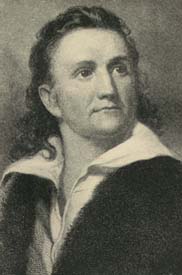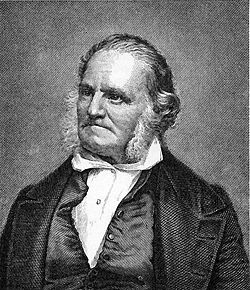John James Audubon
| John James Audubon |
|---|
John James Audubon
|
| Born |
| 26 April 1785 Les Cayes, Haiti (then called : Saint Domingue) |
| Died |
| 27 January 1851 New York |
John James Audubon (April 26, 1785 – January 27, 1851) was an American ornithologist, naturalist, hunter, and painter. He painted, catalogued, and described the birds of North America.
Biography
Audubon was born in Haiti (then called Saint-Domingue), the illegitimate son of Jean Audubon, a French sea captain and slavemaster, and Jeanne Rabin.[1] Rabin's identity is unknown; she has been described as a Creole slave, a black woman from the Congo, and Jean Audubon's chambermaid and mistress.[2] The circumstances of his parentage may have been the basis for later claims that he was instead Louis XVII, the "Lost Dauphin" of France. Since Audubon's parents weren't married, he was first named Jean Rabine (his mother was called Jeanne Rabine).
His father took him to Nantes, France to be raised by his wife, Anne Moynet.[3] He was formally adopted in March 1789 and named Jean-Jacques Fougere Audubon, which he later Americanized. He was educated in Paris, where he took lessons from the French painter Jacques-Louis David.[4]
In 1803, his father obtained a false passport for him to travel to the United States to avoid the Napoleonic Wars. He caught yellow fever and the sea captain placed him in a boarding house run by Quaker women who nursed him to recovery and taught him the unique Quaker form of English. The destination was a family farm in Mill Grove, near Philadelphia[5], where in 1803 he began the study of natural history by conducting the first known bird-banding on the continent: he tied yarn to the legs of Eastern Phoebes and determined that they returned to the same nesting spots year after year[6]. In that year he met and became engaged to his neighbor Lucy Bakewell, whom he married in 1808. He also began drawing and painting birds. In later years he claimed to have hunted in the Appalachians with Daniel Boone.
After years of business success in Pennsylvania and Kentucky, he went bankrupt. This compelled him to pursue his nature study and painting more vigorously, and he sailed down the Mississippi with his gun, paintbox, and assistant, intent on finding and painting all the birds of North America.
On his arrival in New Orleans in the spring of 1821, he lived for a time at 706 Barracks Street. That summer, he moved upriver to the Oakley Plantation in the Felicianas to teach drawing to Eliza Pirrie, the young daughter of the owners, and where he spent much of his time roaming and painting in the woods. (The plantation, located at 11788 Highway 965, between Jackson and St. Francisville, is now Audubon State Historic Site, and guided tours are available almost daily.)
To draw or paint the birds, he shot them first, using fine shot to prevent them from being torn to pieces. He then used fixed wires to prop them up, restoring a natural position. His paintings of birds are set true-to-life in their natural habitat. This was in stark contrast with the stiff representations of birds by his contemporaries, such as Alexander Wilson. Audubon once wrote: "I call birds few when I shoot less than one hundred per day." One of his biographers, Duff Hart-Davis, reveals, "The rarer the bird, the more eagerly he pursued it, never apparently worrying that by killing it he might hasten the extinction of its kind."
Since he had no other income, Audubon eked out a living selling portraits on demand, while his wife, Lucy, worked as a tutor to rich plantation families. He sought a publisher for his birds in Philadelphia but was rebuffed, in part because he had earned the enmity of some of the city's leading scientists at the Academy of Natural Sciences. He didn't have very much luck selling them in America.
Finally, in 1826 he set sail with his portfolio to Liverpool. The British couldn't get enough of images of backwoods America and he was an instant success. He was lionized as "The American Woodsman" and raised enough money to publish his Birds of America. This consisted of hand-colored, life-size prints made from engraved plates measuring around 39 by 26 inches. This original edition was engraved in aquatint by Robert Havell junior; known as the Double Elephant folio, it is often regarded as the greatest picture book ever produced. All 435 of the preparatory watercolors for "The Birds of America" are currently housed at the New-York Historical Society in New York City.
Even King George IV was an avid fan of Audubon. Audubon was elected a fellow of London's Royal Society. In this, he followed the footsteps of Benjamin Franklin, who was the first American fellow. While in Edinburgh to seek subscriptions for his book, he gave a demonstration of his method of using wires to prop up birds at professor Robert Jameson's Wernerian Natural History Association with the student Charles Darwin in the audience and also visited the dissecting theatre of the anatomist Robert Knox (not long before Knox became associated with Burke and Hare).
He followed his Birds of America up with a companion work, Ornithological Biographies, life histories of each species written with Scottish ornithologist William MacGillivray. Both the books of paintings and the biographies were published between 1827 and 1839. The greatest production, published from 1831 to 1893, consisted of five volumes of biographies of birds and four volumes of portraits of birds. The portraits contained over four hundred drawings, colored and life-size.[7]
During that time, Audubon continued making expeditions in North America and bought an estate on the Hudson River, now Audubon Park. In 1842, he published a popular edition of Birds of America in the United States. His final work was on mammals, the Viviparous Quadrupeds of North America, which was written in collaboration with his good friend Rev. John Bachman (of Charleston, South Carolina) who supplied much of the scientific text. It was completed by his sons and son-in-law and published posthumously.
He may be buried in the Trinity Churchyard Cemetery at 155th Street and Broadway in Manhattan, New York where there is an imposing monument in his honor, but the exact location of his remains is unclear.
The National Audubon Society was incorporated and named in his honor in 1905. Several towns and one county (in Iowa) also bear his name. The John James Audubon Parkway in Amherst, New York, which encircles the main campus of the University at Buffalo, is named in his honor.
He started a general store in Louisville, Kentucky, lived in Henderson, Kentucky, and witnessed the 1811-1812 earthquakes. He had two sons: Victor Gifford (b. June 12, 1809) and John Woodhouse (b. November 30, 1812), and two daughters: Lucy (1815-1817) and Rose (1819).
In Henderson, Kentucky, he is remembered by the 692-acre John James Audubon State Park. The Audubon Museum houses many of Audubon’s original watercolors, oils, engravings and personal memorabilia. The Nature Center features a wildlife observatory, which nurtures Audubon’s own love for nature and the great outdoors. The Park offers facilities for camping, hiking, fishing, swimming, golf, and tennis.
In Natchez, Mississippi there is a gallery and, at one time, there was a tableau in the Natchez Pageant dedicated to him.
- Audubon, John James ~ Bobwhite (Virginia Partridge), 1825.jpg
Audubon, John James ~ Bobwhite (Virginia Partridge), 1825
- Audubon, John James ~ White Gerfalcons.jpg
Audubon, John James ~ White Gerfalcons
ReferencesISBN links support NWE through referral fees
- ↑ RootsWeb.com. Retrieved 2007-03-05.
- ↑ Blacks on U.S.A. Postage Stamps. Retrieved 2007-03-05.
- ↑ Audubon
- ↑ "Southern Life"Fulton, Maurice Garland (1917). Southern Life in Southern Literature. Kessinger Publishing, 13.
- ↑ [National Gallery of ARt]
- ↑ Audubon
- ↑ "Southern Life"
Bibliography
Posthumous collections
- John James Audubon, Writings & Drawings (Christoph Irmscher, ed.) (The Library of America, 1999) ISBN 978-1-88301168-0.
- John James Audubon, The Audubon Reader (Richard Rhodes, ed.) (Everyman Library, 2006) ISBN 1-4000-4369-7
External links
- National Gallery of Art: Audubon's Dream Realized: Selections from The Birds of America (exhibition no longer on view).
- National Gallery of Art: Selections from John James Audubon's The Birds of America (1826-1838)
- John James Audubon - The birds of America.Catalog of the 435 plates
- Audubon biography from National Audubon Society
- Harmony A multimedia site combining the original engravings of birds with excerpts of music, literary texts and poetry.
- Full text of the biography John James Audubon by John Burroughs.
- Guide to identifying Audubon prints.
- The Audubon House Gallery for Audubon Art
- National Audubon Society
- Birds of America Online version from an 1840 "First Octavo Edition" of Audubon's complete seven volume text, and presents Audubon's images and original text descriptions
- Pierre-Olivier Combelles, naturalist, author, French specialist of Audubon in Labrador
- American Philosophical Society exhibition: Undaunted: Five American Explorers, 1760-2007
- John James Audubon: Drawn From Nature, PBS, July 25, 2007
| Persondata | |
|---|---|
| NAME | Audubon, John James |
| ALTERNATIVE NAMES | Rabine, Jean (birth name); Audubon, Jean-Jacques Fougere (French) |
| SHORT DESCRIPTION | Ornithologist, naturalist, and painter |
| DATE OF BIRTH | April 26, 1785 |
| PLACE OF BIRTH | Haiti |
| DATE OF DEATH | January 27, 1851 |
| PLACE OF DEATH | |
Credits
New World Encyclopedia writers and editors rewrote and completed the Wikipedia article in accordance with New World Encyclopedia standards. This article abides by terms of the Creative Commons CC-by-sa 3.0 License (CC-by-sa), which may be used and disseminated with proper attribution. Credit is due under the terms of this license that can reference both the New World Encyclopedia contributors and the selfless volunteer contributors of the Wikimedia Foundation. To cite this article click here for a list of acceptable citing formats.The history of earlier contributions by wikipedians is accessible to researchers here:
The history of this article since it was imported to New World Encyclopedia:
Note: Some restrictions may apply to use of individual images which are separately licensed.




